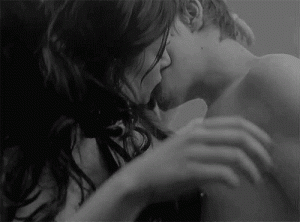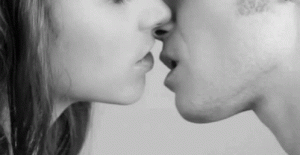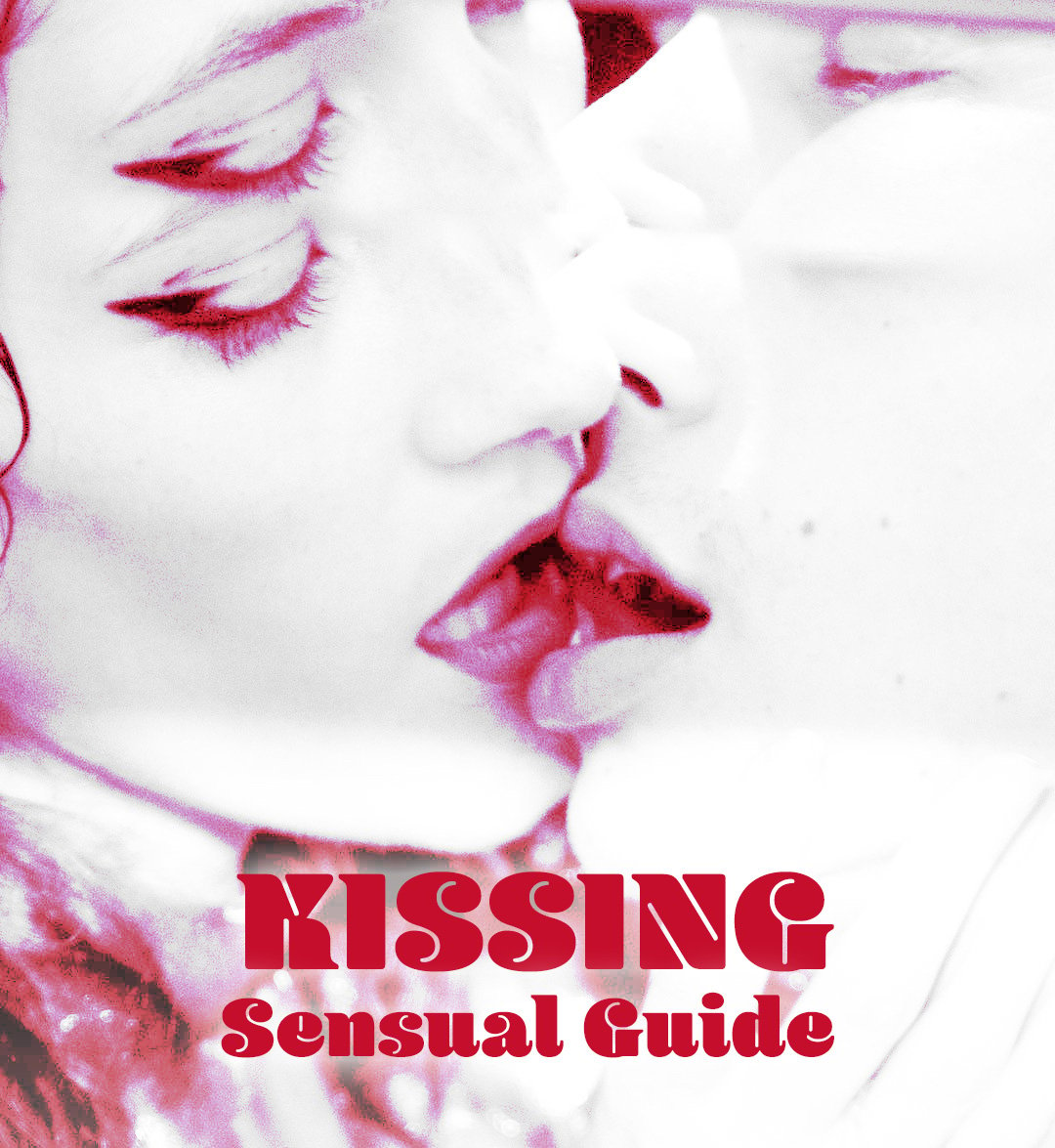From petit pecks on the cheek to full-on tonsil tennis, kissing plays a variety of roles in our intimate human connections. This can include platonic greetings, affectionate friendships, romantic bonding, passionate sexual expression, sexuality exploration and even queer protest. Fear not this guide to kissing will cover it all.
We kiss in many types of ways, for many different reasons, with a culture of kissing that varies across time and space. As a Sensual Intimacy Coach, I’m intimately interested in the sensual science and cultural stories behind kissing; what makes for a weak-kneed, time-stopping kiss; and all of the juicy ways in which we can enhance our lip-locking experiences.
Guide to kissing contents:
– Science
– Culture
– Art
– Game
Kissing as a science
Did you know that humans hold over a million deliciously sensitive nerve endings in our lips? That’s 100 times more than found in our fingertips. With this extra sensitivity comes a whole host of emotional and physiological benefits to kissing.
Professor of Medicine, Dr Joseph Stephen Alpert explains that a simple kiss may only use around “2 muscles and burn only 2 to 3 calories, whereas passionate kissing can involve as many as 23 to 34 facial muscles and 112 postural muscles,” burning between 5 and 26 calories a minute—making it a pretty good facial workout.
Psychologist and Relationship Expert, Dr John Gottmann argues that a regular six-second kiss can be enough to improve your relationship. “It’s long enough to make a moment of connection with our partner. It stops the busyness in your brain and puts your focus on your partner at that moment.”
This is because feel-good chemicals are released when we kiss, including dopamine, oxytocin, serotonin, and endorphins, all of which reduce the rate of the stress hormone cortisol, creating feelings of relaxation and even arousal. In an exceptionally passionate make-out session, there may also be a release of adrenaline that increases our heart rate, breathing, and release of sweat.
Some researchers hypothesise that the reason we kiss may come from a (not-so-sexy) evolutionary practice from primitive passing of food from the parent to the baby, forming early connections of pleasure with mouth-to-mouth contact.
Additionally, Science Journalist Melissa Hogenboom suggests that kissing may play a part in ‘mate assessment’. This closeness allows for the transference of important information through smell. This can include “diet, presence of disease, mood and relatedness” in order to discern whether a partner may be compatible.
It’s probably fair to say that kissing may also indicate compatibility depending on whether two people’s lips lock in a mutually pleasurable way.

When it comes to kissing and sex, research has found that women are more likely to use kissing as a means of maintaining a relationship, while men are more likely to use kissing to increase the likelihood of sex. Nevertheless, it has been found that women are more likely to orgasm if their sexual encounter includes “deep kissing,” and, not only that, but it has been reported that some women can orgasm from just kissing!
Kissing as a culture
Kissing doesn’t always take place on the lips or even the cheeks, as we explore in this guide to kissing. Historically, the hand kiss has been passed down through Western chivalry as a sign of respect when courting, and the forehead kiss is often seen as a sign of endearment. Sexologists say this is beneficial for emotional wellbeing.
While previously it was thought that 90% of people globally kiss for romantic or sexual reasons, a more recent study found that less than half (46%) of cultures around the world engage in romantic-sexual kissing. According to the American Anthropologist, it is argued that the dominant idea around this type of kissing being “universal” may be due to Western ethnocentrism, often disseminated through media via globalisation.
Across cultures, kissing has many different meanings and levels of acceptance. For example, in many countries outside of Western Europe, public displays of affection are frowned upon, regardless of whether it is between heterosexual couples or members of the same sex, due to local or religious customs.
For LGBTQ+ people, at least in the West, kissing can be an empowering practice of self-exploration and self-identification growing up within a culture of morality and compulsory heterosexuality. A recent study found that the “average person kisses 21.5 people in their lifetime.” Pink News reported that this is not the case for queer people who took to social media to poke fun at this statistic: “This is how many people I kiss over a weekend,” one user writes. “Straight people, what are you doing? Free yourselves.”
As well as for expressive means, queer people have been using kissing for political purposes. When faced with oppressive homophobic laws, queer people have historically used the act of kissing as an act of nonviolent protest in the form of public “kiss-ins”.
So now our guide to kissing has now explored some of the nerdy science and cultural stories around why we may or may not kiss, I’m excited to explore the how.
Guide to kissing as an art
Kisses can be given. Kisses can be received. While most commonly held between two pairs of lips, they can be placed on various parts of the body, such as the hands, arms, and neck; various parts of the face, such as the cheek, forehead, and nose; and even in more erogenous zones such as the nipples, thighs, and even genitals – while we’d probably just call that oral sex, it is ultimately a type of kiss!
Kisses can be hard, soft, gentle, wet, deep. They could be one long smooch, or lots of light “fairy” pecks. But what makes a kiss a really good one? Is there really an art to it? Or does it depend on the person’s tastes and styles?

I put out some feelers on Instagram to find out from my followers what makes for a “good” kiss compared with a “not-so-good” kiss.
While only 4% of respondents claimed that they’ve only had “great” kissing experiences, 75% shared that they can recall a particularly “bad” one:
– “Closed mouth and no tongue. It was like when I used to practise kissing myself in the mirror.”
– “Tongue poking in and out like a newt.”
– “Mechanical, aggressive and lacking connection.”
– “Attempting to bite my lip in a playful way, but just repeatedly making my eyes water.”
– “All I could taste and smell was garlic.”
Ouch. Now let’s take a look at some of the more positive experiences of what might make for a good kiss:
– “Synchronised rhythm and mutual desire for exploration.”
– “Love a hungry kiss when you want each other so bad!”
– “Moist, soft, mellow, alternation of soft and a bit stronger, mouth not too open. Tongue now and then.”
– “Open mouth and tongue have to be involved.”
– “When you become oblivious to everything else going on around you.”
So taking into account these varied kissing experiences, there may be some practical insights we can take away…
How to kiss confidently with our top kissing tips
Pucker-Up Preparation: You’ll want to make the experience pleasant for both of you, so there’s no harm in having good dental hygiene and lip care.
Connection is Key: Make sure you are on the same page, so like a dance, follow the rhythm and flow.
Biters Beware: A gentle nibble can be super hot, but best to avoid causing them actual pain unless they’ve explicitly asked for it.
Tongue Etiquette: It might be a good idea to start off with no tongue and gradually invite it in while noticing if the other person responds with more tongue or less.
Sensual Awareness: If you notice yourself overthinking the kiss, try paying attention to the senses; the sound of your breath or theirs, the smell of their skin, the texture of their lips, and the taste of their tongue.
Body Engagement: Don’t just focus on the contact between your lips, but what is the rest of your body doing. Press your bodies close to each other, hold their face with your hands, run your fingers through their hair, maybe even giving it a tug for a more kinky and passionate kiss.
Art of the Tease: Playing with power can be a really enticing addition to kissing. Exploring going in for the kiss, offering tentative or intense kisses, and gently pulling away to see how they react, leaving them wanting more.
Kissing as a game
And no, I don’t mean Spin-the-Bottle! But by all means, let’s bring that one back.
If you are looking to deepen your kissing practice, you might want to add an element of play and curiosity into it.
Dr Betty Martin, founder of the Wheel of Consent, teaches about the four different types of touch that flow between two people in a physical interaction: giving, receiving, allowing, taking. She was inspired by the 3-Minute Game created by Harry Faddis. It is designed to explore these different types of touch – practised with sexual and non-sexual touch, and can be equally applied to kissing.

Version 1
Can you kiss me?
Can I kiss you?
Version 2
How would you like me to kiss you for three minutes?
How would you like to kiss me for three minutes?
Each partner takes it in turn to ask each question, so there are four rounds of question and answer. Between each question, the recipient may take a moment to consider what they want before responding.
This practice gives you the opportunity to express what kinds of kissing you want and to learn about what a partner wants, as well as providing a framework for consent and checking whether you even want to kiss at that moment and what that would look and feel like!
Just like with any area of our sex life and relationships, while we are “expected” to know everything, intimacy takes time, communication, practice, vulnerability, and continued learning. With each partner, and each day, comes a whole new set of preferences, rules, likes, dislikes.
So having read this guide to kissing be open-minded to trying something new and let your lips do their thing.



